Geodynamic Mechanism of the Evolution of the South China Sea Basin: Simulation Based on the Finite Difference Method
Abstract
1. Introduction
2. Geological Background
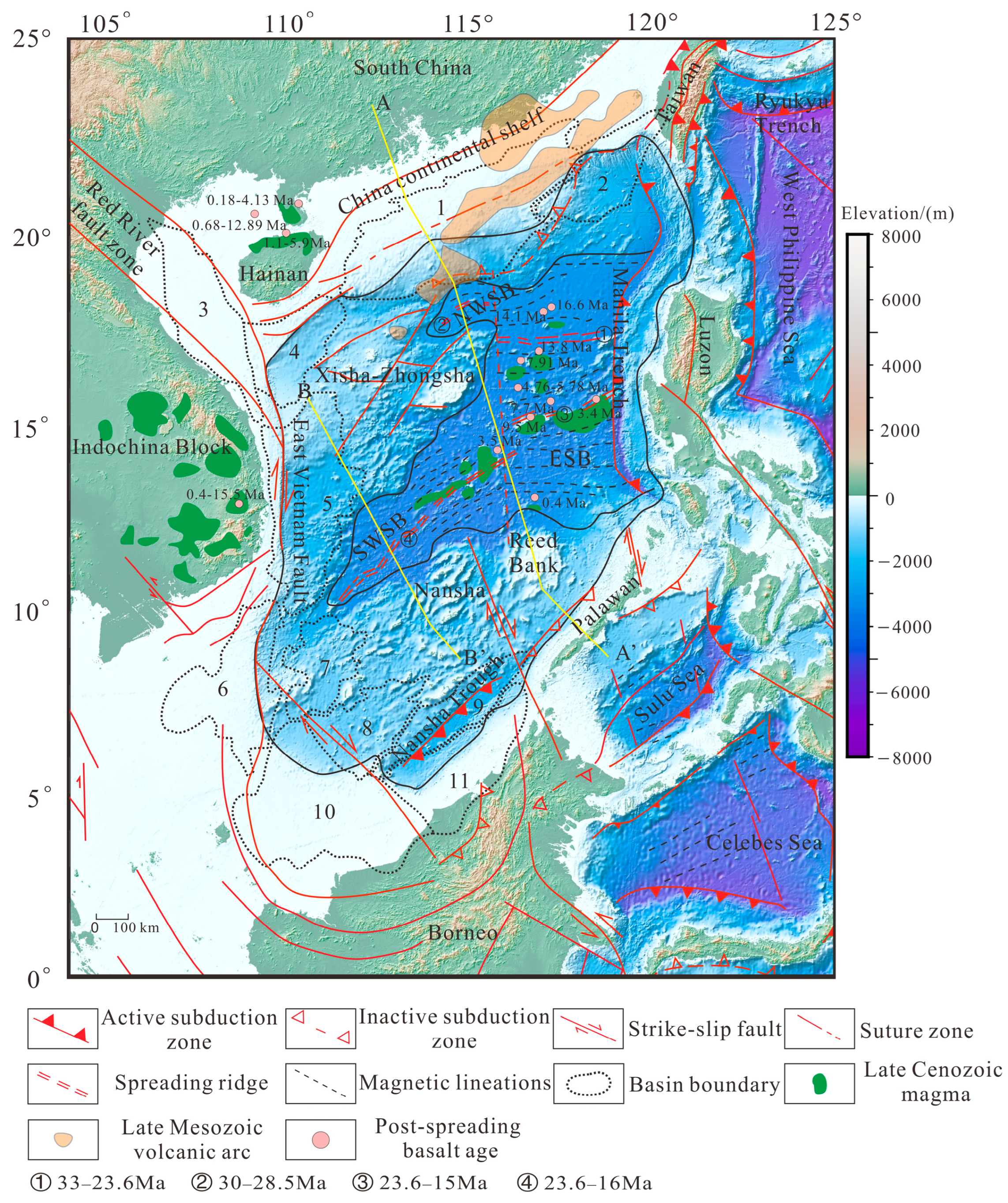
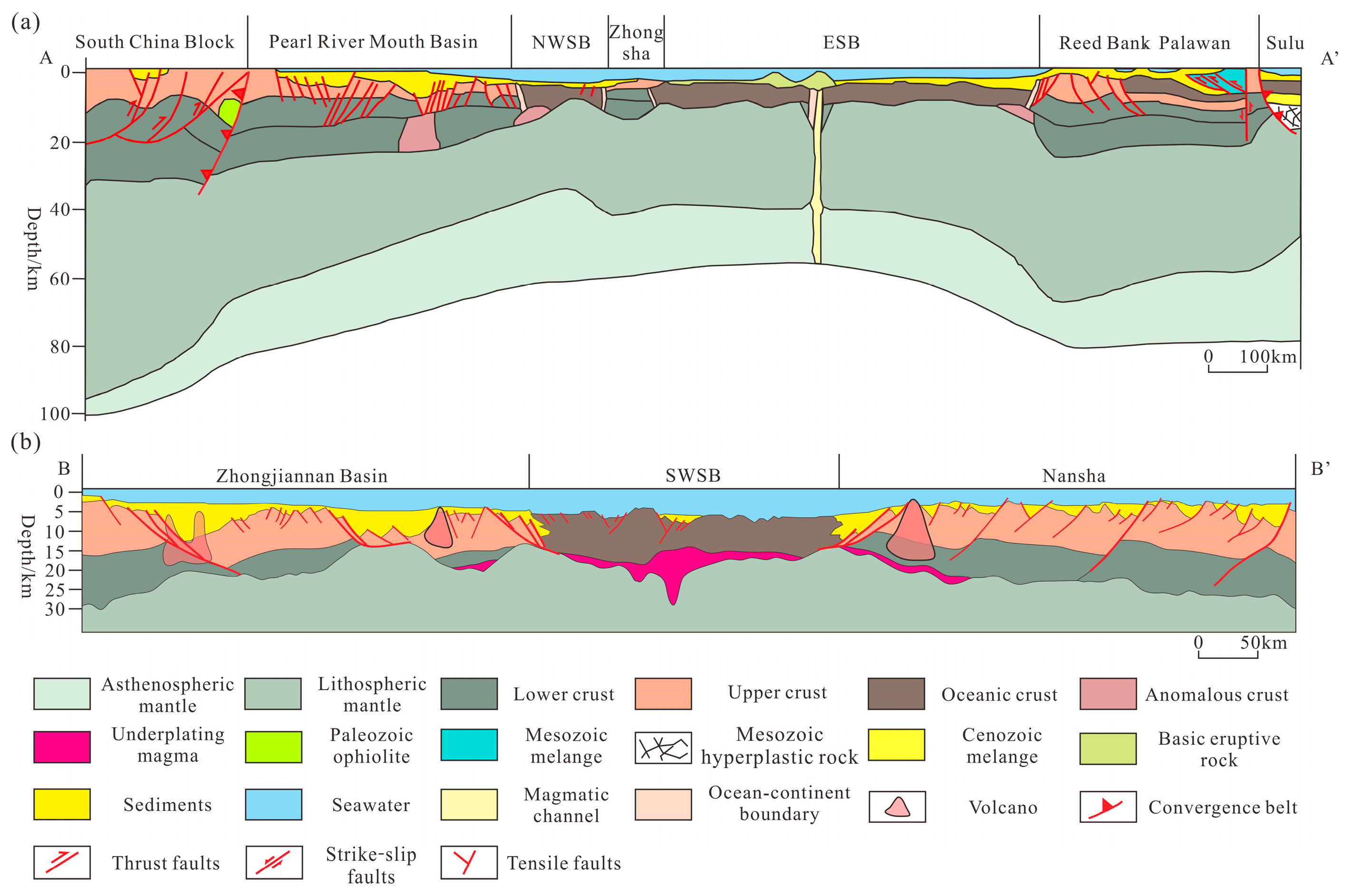
3. Methods and Model Setup
3.1. Methods
3.1.1. Continuity Equation
3.1.2. Momentum Equation
3.1.3. Heat Conservation Equation
3.1.4. Rock Density and Rheology
3.2. Model Setup
4. Results
5. Discussion
6. Conclusions
Author Contributions
Funding
Institutional Review Board Statement
Informed Consent Statement
Data Availability Statement
Acknowledgments
Conflicts of Interest
References
- Larsen, H.C.; Mohn, G.; Nirrengarten, M.; Sun, Z.; Stock, J.; Jian, Z.; Klaus, A.; Alvarez-Zarikian, C.A.; Boaga, J.; Bowden, S.A.; et al. Rapid transition from continental breakup to igneous oceanic crust in the South China Sea. Nat. Geosci. 2018, 11, 782–789. [Google Scholar] [CrossRef]
- Wang, P.X. Exploring the deep sea processes in the South China Sea. Sci. Technol. Rev. 2020, 38, 6–20. (In Chinese) [Google Scholar] [CrossRef]
- Franke, D.; Savva, D.; Pubellier, M.; Steuer, S.; Mouly, B.; Auxietre, J.; Meresse, F.; Chamot-Rooke, N. The final rifting evolution in the South China Sea. Mar. Pet. Geol. 2014, 58, 704–720. [Google Scholar] [CrossRef]
- Wang, P.C.; Li, S.Z.; Suo, Y.H.; Guo, L.L.; Wang, G.Z.; Hui, G.G.; Santosh, M.; Somerville, D.; Cao, X.Z.; Li, Y. Plate tectonic control on the formation and tectonic migration of Cenozoic basins in northern margin of the South China Sea. Geosci. Front. 2020, 11, 1231–1251. [Google Scholar] [CrossRef]
- Wen, Y.L.; Li, C.F.; Wang, L.J.; Liu, Y.T.; Peng, X.; Yao, Z.W.; Yao, Y.J. The onset of seafloor spreading at the northeastern continent-ocean boundary of the South China Sea. Mar. Pet. Geol. 2021, 133, 105255. [Google Scholar] [CrossRef]
- Pang, X.; Zheng, J.Y.; Mei, L.F.; Liu, B.J.; Zhang, Z.T.; Wu, Z.; Feng, X. Characteristics and origin of continental marginal fault depressions under the background of preexisting subduction continental margin, northern South China Sea, China. Pet. Explor. Dev. Online 2021, 48, 1237–1250. [Google Scholar] [CrossRef]
- Bai, Y.L.; Wang, X.Y.; Dong, D.D.; Brune, S.; Wu, S.G.; Wang, Z.J. Symmetry of the South China Sea conjugate margins in a rifting, drifting and collision context. Mar. Pet. Geol. 2020, 117, 104397. [Google Scholar] [CrossRef]
- Luo, X.G.; Wang, W.Y.; Zhang, G.C.; Zhao, Z.G.; Liu, J.L.; Xie, X.J.; Qiu, Z.Y.; Feng, X.L.; Ji, X.L.; Wang, D.D. Study on distribution features of faults based on gravity data in the South China Sea and its adjacent areas. Chin. J. Geophys. 2018, 61, 4255–4268. (In Chinese) [Google Scholar] [CrossRef]
- Avraham, B.Z.; Uyeda, S. The evolution of the China Basin and the mesozoic paleogeography of Borneo. Earth Planet. Sci. Lett. 1973, 18, 365–376. [Google Scholar] [CrossRef]
- Karig, D.E. Origin and development of marginal basins in the western Pacific. J. Geophys. Res. 1971, 76, 2542–2561. [Google Scholar] [CrossRef]
- Jiang, X.; Wang, Z.C. A critical review of existing models for the origin of the South China Sea and a new proposed model. J. Asian Earth Sci. X 2021, 6, 100065. [Google Scholar] [CrossRef]
- Li, J.B.; Ding, W.W.; Lin, J.; Xu, Y.G.; Kong, F.S.; Li, S.Z.; Huang, X.L.; Zhou, Z.Y. Dynamic processes of the curved subduction system in Southeast Asia: A review and future perspective. Earth-Sci. Rev. 2021, 217, 103647. [Google Scholar] [CrossRef]
- Taylor, B.; Karner, G.D. On the evolution of marginal basins. Rev. Geophys. 1983, 21, 1727–1741. [Google Scholar] [CrossRef]
- Morley, C.K. Late Cretaceous–Early Palaeogene tectonic development of SE Asia. Earth Sci. Rev. 2012, 115, 37–75. [Google Scholar] [CrossRef]
- Stern, R.J.; Bloomer, S.H. Subduction zone infancy: Examples from the Eocene Izu-Bonin-Mariana and Jurassic California arcs. Geol. Soc. Am. Bull. 1992, 104, 1621–1636. [Google Scholar] [CrossRef]
- Huang, C.Y.; Wang, P.X.; Yu, M.M.; You, C.F.; Liu, C.S.; Zhao, X.X.; Shao, L.; Zhong, G.F.; Yumul, G.P. Potential role of strike-slip faults in opening up the South China Sea. Natl. Sci. Rev. 2019, 6, 891–901. [Google Scholar] [CrossRef] [PubMed]
- Holloway, N.H. North Palawan Block, Philippines; its relation to Asian mainland and role in evolution of South China Sea. AAPG Bull. 1982, 66, 1355–1383. [Google Scholar] [CrossRef]
- Cao, L.C.; Shao, L.; Qiao, P.J.; Cui, Y.C. Formation and paleogeographic evolution of the Palawan continental terrane along the Southeast Asian margin revealed by detrital fingerprints. Geol. Soc. Am. Bull. 2020, 133, 1167–1193. [Google Scholar] [CrossRef]
- Briais, A.; Patriat, P.; Tapponnier, P. Updated interpretation of magnetic anomalies and seafloor spreading stages in the south China Sea: Implications for the Tertiary tectonics of Southeast Asia. J. Geophys. Res. 1993, 98, 6299–6328. [Google Scholar] [CrossRef]
- Tapponnier, P.; Peltzer, G.; Armijo, R. On the mechanics of the collision between India and Asia. Geol. Soc. Lond. Spec. Publ. 1986, 19, 113–157. [Google Scholar] [CrossRef]
- Hall, R. Cenozoic geological and plate tectonic evolution of SE Asia and the SW Pacific: Computer-based reconstructions, model and animations. J. Asian Earth Sci. 2002, 20, 353–431. [Google Scholar] [CrossRef]
- Hall, R. Late Jurassic-Cenozoic reconstructions of the Indonesian region and the Indian Ocean. Tectonophysics 2012, 570–571, 1–41. [Google Scholar] [CrossRef]
- Hall, R.; Breitfeld, H.T. Nature and demise of the proto-South China Sea. Bull. Geol. Soc. Malays. 2017, 63, 61–76. [Google Scholar] [CrossRef]
- Burton-Johnson, A.; Cullen, A. Continental rifting in the South China Sea through extension and high heat flow: An extended history. Gondwana Res. 2023, 120, 235–263. [Google Scholar] [CrossRef]
- Wu, J.; Suppe, J. Proto-South China Sea plate tectonics using subducted slab constraints from tomography. J. Earth Sci. 2018, 29, 1304–1318. [Google Scholar] [CrossRef]
- Lin, J.; Sun, Z.; Li, J.B.; Zhou, Z.Y.; Zhang, F.; Luo, Y.M. South China Sea basin opening: Lithospheric Rifting and Interaction with Surrounding Subduction Zones. Sci. Technol. Rev. 2020, 38, 35–39. (In Chinese) [Google Scholar] [CrossRef]
- Mai, H.A.; Chan, Y.L.; Yeh, M.W.; Lee, T.Y. Tectonic implications of Mesozoic magmatism to initiation of Cenozoic basin development within the passive South China Sea margin. Int. J. Earth Sci. 2018, 107, 1153–1174. [Google Scholar] [CrossRef]
- Wang, P.C.; Li, S.Z.; Suo, Y.H.; Guo, L.L.; Santosh, M.; Li, X.Y.; Wang, G.Z.; Jiang, Z.X.; Liu, B.; Zhou, J.; et al. Structural and kinematic analysis of Cenozoic rift basins in South China Sea: A synthesis. Earth-Sci. Rev. 2021, 216, 103522. [Google Scholar] [CrossRef]
- Wang, Z.C.; Li, J.H.; Feng, Z.Q.; Wang, L.J.; Liu, C. Mechanism of Structure Variations at Rifted Margins in the Central Segment of South Atlantic: Insights from Numerical Modeling. Acta Geol. Sin. Engl. Ed. 2023, 97, 1229–1242. [Google Scholar] [CrossRef]
- Sun, W.D. Initiation and evolution of the South China Sea: An overview. Acta Geochim. 2016, 35, 215–225. [Google Scholar] [CrossRef]
- Li, C.F.; Xu, X.; Lin, J.; Sun, Z.; Zhu, J.; Yao, Y.J.; Zhao, X.X.; Liu, Q.S.; Kulhanek, D.K.; Wang, J.; et al. Ages and magnetic structures of the South China Sea constrained by deep tow magnetic surveys and IODP Expedition 349. Geochem. Geophys. Geosystems 2014, 15, 4958–4983. [Google Scholar] [CrossRef]
- Sibuet, J.C.; Yeh, Y.C.; Lee, C.S. Geodynamics of the South China Sea. Tectonophysics 2016, 692, 98–119. [Google Scholar] [CrossRef]
- Feng, X.L.; Zhang, G.C.; Wang, W.Y.; Zhao, Z.G.; Qiu, Z.Y.; Xie, X.J.; Ji, X.L.; Lu, B.L.; Song, S. An integrated study on distribution of Cenozoic basins in the South China Sea based on gravity, magnetic and seismic data. Chin. J. Geophys. 2018, 61, 4242–4254. (In Chinese) [Google Scholar] [CrossRef]
- Li, Y.H.; Huang, H.B.; He, E.Y.; Cao, L.M.; Qiu, X.L.; Guo, X.W.; Liu, H.L. Tectonic framework of miniature continental block-narrow oceanic basin revealed by the southern typical profile in the China seas-Western Pacific Ocean. Chin. J. Geophys. 2020, 63, 1938–1958. (In Chinese) [Google Scholar] [CrossRef]
- Safonova, I.; Maruyama, S. Asia: A frontier for a future supercontinent Amasia. Int. Geol. Rev. 2014, 56, 1051–1071. [Google Scholar] [CrossRef]
- Ding, W.W.; Sun, Z.; Mohn, G.; Nirrengarten, M.; Tugend, J.; Manatschal, G.; Li, J.B. Lateral evolution of the rift-to-drift transition in the South China Sea: Evidence from multi-channel seismic data and IODP Expeditions 367&368 drilling results. Earth Planet. Sci. Lett. 2020, 531, 115932. [Google Scholar] [CrossRef]
- Jian, Z.M.; Jin, H.Y.; Kaminski, M.A.; Ferreira, F.; Li, B.H.; Yu, P.S. Discovery of the marine Eocene in the northern South China Sea. Natl. Sci. Rev. 2019, 6, 881–885. [Google Scholar] [CrossRef] [PubMed]
- Sun, Z.; Lin, J.; Qiu, N.; Jian, Z.M.; Wang, P.X.; Pang, X.; Zheng, J.Y.; Zhu, B.D. The role of magmatism in thinning and breakup of the South China Sea continental margin. Natl. Sci. Rev. 2019, 6, 871–876. [Google Scholar] [CrossRef] [PubMed]
- Wessel, P.; Luis, J.F.; Uieda, L.; Scharroo, R.; Wobbe, F.; Smith, W.H.F.; Tian, D. The Generic Mapping Tools Version 6. Geochem. Geophys. Geosystems 2019, 20, 5556–5564. [Google Scholar] [CrossRef]
- Tozer, B.; Sandwell, D.T.; Smith, W.H.; Olson, C.; Beale, J.R.; Wessel, P. Global Bathymetry and Topography at 15 Arc Sec: SRTM15+. Earth Space Sci. 2019, 6, 1847–1864. [Google Scholar] [CrossRef]
- Lin, J.; Xu, Y.G.; Sun, Z.; Zhou, Z.Y. Mantle upwelling beneath the South China Sea and links to surrounding subduction systems. Natl. Sci. Rev. 2019, 6, 877–881. [Google Scholar] [CrossRef] [PubMed]
- Wang, P.X. Tracing the life history of a marginal Sea—On the “South China Sea Deep” Research Program. Chin. Sci. Bull. 2012, 57, 1807–1826. [Google Scholar] [CrossRef]
- Zhou, D.; Yao, B.C. Tectonics and sedimentary basins of the South China Sea: Challenges and progresses. J. Earth Sci. 2009, 20, 1–12. [Google Scholar] [CrossRef]
- Li, Y.Q.; Abbas, A.; Li, C.F.; Sun, T.N.; Zlotnik, S.; Song, T.R.; Zhang, L.L.; Yao, Z.W.; Yao, Y.J. Numerical modeling of failed rifts in the northern South China Sea margin: Implications for continental rifting and breakup. J. Asian Earth Sci. 2020, 199, 104402. [Google Scholar] [CrossRef]
- Tian, Z.X.; Yan, Y.; Huang, C.Y.; Dilek, Y.; Yu, M.M.; Liu, H.Q.; Zhang, X.C.; Zhang, Y. Fingerprinting Subducted Oceanic Crust and Hainan Plume in the Melt Sources of Cenozoic Basalts from the South China Sea Region. Terra Nova 2020, 33, 21–29. [Google Scholar] [CrossRef]
- Xu, J.Y.; Avraham, Z.B.; Kelty, T.; Yu, H.S. Origin of marginal basins of the NW Pacific and their plate tectonic reconstructions. Earth Sci. Rev. 2014, 130, 154–196. [Google Scholar] [CrossRef]
- Dong, D.D.; Qian, J.; Marta, P.G.; Lu, Z.J.; Luan, Y. Structural asymmetry of conjugate margins of the South China Sea and numerical modeling for its formation. Mar. Sci. 2014, 38, 136–141. (In Chinese) [Google Scholar] [CrossRef]
- Gozzard, S.; Kusznir, N.; Franke, D.; Cullen, A.; Reemst, P.; Henstra, G. South China Sea crustal thickness and oceanic lithosphere distribution from satellite gravity inversion. Pet. Geosci. 2019, 25, 112–128. [Google Scholar] [CrossRef]
- Ren, J.Y.; Luo, P.; Gao, Y.Y.; Wang, H.J.; Lei, C.; Chao, P. Structural, Sedimentary and Magmatic Records during Continental Breakup at Southwest Sub-Basin of South China Sea. Earth Sci. 2022, 47, 2287–2302. (In Chinese) [Google Scholar] [CrossRef]
- Zhao, Z.X.; Sun, Z.; Qiu, N.; Zhao, M.H.; Zhang, J.Z.; Li, F.C.; Lin, J.; Lee, E.Y. The paleo-lithospheric structure and rifting-magmatic processes of the northern South China Sea passive margin. Gondwana Res. 2023, 120, 162–174. [Google Scholar] [CrossRef]
- Liu, C.; Li, J.H.; Wang, Z.C. Dynamic model analysis of formation and evolution of the South China Sea. Geoscience 2023, 7, 259–269. (In Chinese) [Google Scholar] [CrossRef]
- Maus, S.; Barckhausen, U.; Berkenbosch, H.; Bournas, N.; Brozena, J.; Childers, V.; Dostaler, F.; Fairhead, J.D.; Finn, C.; von Frese, R.R.B.; et al. EMAG2: A 2–arc min resolution Earth Magnetic Anomaly Grid compiled from satellite, airborne, and marine magnetic measurements. Geochem. Geophys. Geosystems 2009, 10, 1–12. [Google Scholar] [CrossRef]
- Zhang, J.; Yang, G.L.; Tan, H.B.; Wu, G.J.; Wang, J.P. Mapping the Moho depth and ocean-continent transition in the South China Sea using gravity inversion. J. Asian Earth Sci. 2021, 218, 104864. [Google Scholar] [CrossRef]
- Guan, Q.S.; Zhang, T.; Tayor, B.; Gao, J.Y.; Li, J.B. Ridge jump reorientation of the South China Sea revealed by high-resolution magnetic data. Terra Nova 2021, 33, 475–482. [Google Scholar] [CrossRef]
- Chang, S.P.; Pubellier, M.; Delescluse, M.; Qiu, Y.; Nirrengarten, M.; Mohn, G.; Chamot-Rooke, N.; Liang, Y. Crustal architecture and evolution of the southwestern South China Sea: Implications to continental breakup. Mar. Pet. Geol. 2022, 136, 105450. [Google Scholar] [CrossRef]
- Peng, X.; Li, C.F.; Shen, C.B.; Li, K.; Zhao, Z.G.; Xie, X.J. Anomalous lower crustal structure and origin of magmatism in the southeastern margin of the South China Sea. Mar. Pet. Geol. 2020, 122, 104711. [Google Scholar] [CrossRef]
- Gao, J.W.; Wu, S.G.; Lüdmann, T.; Li, C.F.; Li, L.; Lu, Y.T.; Yang, Z.L.; Tian, L.Y.; Qin, Y.P.; Song, T.R. Extensional structures and Cenozoic magmatism in the northwestern South China Sea. Gondwana Res. 2023, 120, 219–234. [Google Scholar] [CrossRef]
- Gerya, T.; Yuen, D.A. Characteristics-based marker-in-cell method with conservative finite-differences schemes for modeling geological flows with strongly variable transport properties. Phys. Earth Planet. Inter. 2003, 140, 293–318. [Google Scholar] [CrossRef]
- Gerya, T. Introduction to Numerical Geodynamic Modelling; Cambridge University Press: Cambridge, UK, 2019. [Google Scholar] [CrossRef]
- Schubert, G.; Turcotte, D.L.; Olson, P. Mantle Convection in the Earth and Planets; Cambridge University Press: Cambridge, UK, 2001. [Google Scholar] [CrossRef]
- Clauser, C.; Huenges, E. Thermal Conductivity of Rocks and Minerals; American Geophysical Union (AGU): Washington, DC, USA, 1995. [Google Scholar] [CrossRef]
- Ranalli, G.; Rybach, L. Heat flow, heat transfer and lithosphere rheology in geothermal areas: Features and examples. J. Volcanol. Geotherm. Res. 2005, 148, 3–19. [Google Scholar] [CrossRef]
- Zhang, J.J.; Shang, S.; Wei, C.J.; Zhang, N.; Zhang, G.W.; Jin, Z.M.; Zhang, J.F.; Cao, S.Y.; Liu, J.L.; Liu, Y.J. Present Status and Development Prospect of Studies of Rheology of Continental Lithosphere. Acta Geosci. Sin. 2019, 40, 9–16. (In Chinese) [Google Scholar] [CrossRef]
- Ranalli, G. Rheology of the Earth. Tectonophysics 1995, 269, 347–349. [Google Scholar] [CrossRef]
- Gerya, T.V.; Yuen, D.A. Robust characteristics method for modelling multiphase visco-elasto-plastic thermo-mechanical problems. Phys. Earth Planet. Inter. 2007, 163, 83–105. [Google Scholar] [CrossRef]
- Burov, E.; Poliakov, A. Erosion and rheology controls on synrift and postrift evolution: Verifying old and new ideas using a fully coupled numerical model. J. Geophys. Res. Solid Earth 2001, 106, 16461–16481. [Google Scholar] [CrossRef]
- Lu, B.L.; Wang, W.Y.; Zhao, Z.G.; Feng, X.L.; Zhang, G.C.; Luo, X.G.; Yao, P.; Ji, X.L. Characteristics of deep structure in the South China Sea and geological implications: Insights from gravity and magnetic inversion. Chin. J. Geophys. 2018, 61, 4231–4241. (In Chinese) [Google Scholar] [CrossRef]
- Qian, K.; Yan, Y.; Huang, Q.Y.; Chen, W.H.; Yu, M.M.; Tian, Z.X. Sea Floor Spreading of South China Sea and Its Depositional Records of Sea and Land Changes. Mar. Geol. Front. 2016, 32, 10–23. (In Chinese) [Google Scholar] [CrossRef]
- Zhang, G.C.; Jia, Q.J.; Wang, W.Y.; Wang, P.J.; Zhao, Q.L.; Sun, X.M.; Xie, X.J.; Zhao, Z.; Tang, W. On tectonic framework and evolution of the South China Sea. Chin. J. Geophys. 2018, 61, 4194–4215. (In Chinese) [Google Scholar] [CrossRef]
- Li, Z.K.; Li, C.F.; Zhu, S.; Huang, L.; Liu, W.X. High-resolution effective elastic thicknesses of the lithosphere in the South China Sea and their controlling factors. Acta Geol. Sin. 2022, 96, 2670–2682. [Google Scholar] [CrossRef]
- Zheng, J.Y.; Dai, Y.D.; Liu, J.; Pang, X.; Ren, J.Y.; Dong, M. Differences in continental crust structure and its extensional fracture process in northern South China Sea. J. Yangtze Univ. Nat. Sci. Ed. 2022, 19, 12–22. (In Chinese) [Google Scholar] [CrossRef]
- Ren, J.Y.; Pang, X.; Yu, P.; Lei, C.; Luo, P. Characteristics and formation mechanism of deepwater and ultra-deepwater basins in the northern continental margin of the South China Sea. Chin. J. Geophys. 2018, 61, 4901–4920. (In Chinese) [Google Scholar] [CrossRef]
- Zhang, J.; Xiong, L.P.; Wang, J. Characteristics and Mechanism of Geodynamic evolution of the South China Sea. Chin. J. Geophys. 2001, 44, 602–610. (In Chinese) [Google Scholar] [CrossRef]
- Zhang, N.; Li, Z. Formation of mantle “lone plumes” in the global downwelling zone—A multiscale modelling of subduction-controlled plume generation beneath the South China Sea. Tectonophysics 2018, 723, 1–13. [Google Scholar] [CrossRef]
- Li, F.C.; Sun, Z.; Pang, X.; Liao, J.; Yang, H.F.; Xie, H.; Zhuo, H.T.; Zhao, Z.X. Low-Viscosity Crustal Layer Controls the Crustal Architecture and Thermal Distribution at Hyperextended Margins: Modeling Insight and Application to the Northern South China Sea Margin. Geochem. Geophys. Geosystems 2019, 20, 3248–3267. [Google Scholar] [CrossRef]
- Crameri, F.; Tackley, P.; Meilick, I.; Gerya, T.; Kaus, B. A free plate surface and weak oceanic crust produce single-sided subduction on Earth. Geophys. Res. Lett. 2012, 39, 1–7. [Google Scholar] [CrossRef]
- Xin, Y.F.; Yan, Y.; Marta, P.G.; Luo, Y. Impact of Extension Rate and Crustal Rheology on the Evolution of Passive Continental Margins. Geotecton. Metallog. 2022, 46, 191–201. (In Chinese) [Google Scholar] [CrossRef]
- Burov, E. Rheology and strength of the lithosphere. Mar. Pet. Geol. 2011, 28, 1402–1443. [Google Scholar] [CrossRef]
- Dymkova, D.; Gerya, T.; Burg, J. 2D thermomechanical modelling of continent–arc–continent collision. Gondwana Res. 2016, 32, 138–150. [Google Scholar] [CrossRef]
- Hung, T.D.; Yang, T.; Le, B.M.; Yu, Y.Q.; Xue, M.; Liu, B.H.; Liu, C.G.; Wang, J.; Pan, M.H.; Huong, P.T.; et al. Crustal Structure Across the Extinct Mid-Ocean Ridge in South China Sea from OBS Receiver Functions: Insights Into the Spreading Rate and Magma Supply Prior to the Ridge Cessation. Geophys. Res. Lett. 2021, 48, e2020GL089755. [Google Scholar] [CrossRef]
- Barckhausen, U.; Engels, M.; Franke, D.; Ladage, S.; Pubellier, M. Evolution of the South China Sea: Revised ages for breakup and seafloor spreading. Mar. Pet. Geol. 2014, 58, 599–611. [Google Scholar] [CrossRef]
- Yu, J.H.; Yan, P.; Qiu, Y.; Delescluse, M.; Huang, W.K.; Wang, Y.L. Oceanic crustal structures and temporal variations of magmatic budget during seafloor spreading in the East Sub-basin of the South China Sea. Mar. Geol. 2021, 436, 106475. [Google Scholar] [CrossRef]
- Sun, Z.; Li, F.C.; Lin, J.; Sun, L.T.; Pang, X.; Zheng, J.Y. The Rifting-Breakup Process of the Passive Continental Margin and Its Relationship with Magmatism: The Attribution of the South China Sea. Earth Sci. 2021, 46, 770–789. (In Chinese) [Google Scholar] [CrossRef]
- Ren, J.Y.; Pang, X.; Lei, C.; Yuan, L.Z.; Liu, J.; Yang, L.L. Ocean and continent transition in passive continental margins and analysis of lithospheric extension and breakup process: Implication for research of the deepwater basins in the continental margins of South China Sea. Earth Sci. Front. 2015, 22, 102–114. (In Chinese) [Google Scholar] [CrossRef]
- Manatschal, G. New models for evolution of magma-poor rifted margins based on a review of data and concepts from West Iberia and the Alps. Int. J. Earth Sci. 2004, 93, 432–466. [Google Scholar] [CrossRef]
- Manatschal, G.; Sauter, D.; Karpoff, A.M.; Masini, E.; Mohn, G.; Lagabrielle, Y. The Chenaillet Ophiolite in the French/Italian Alps: An ancient analogue for an Oceanic Core Complex? Lithos 2011, 124, 169–184. [Google Scholar] [CrossRef]
- Zhang, C.M.; Sun, Z.; Manatschal, G.; Pang, X.; Li, S.Z.; Sauter, D.; Peron-Pinvidic, G.; Zhao, M.H. Ocean-continent transition architecture and breakup mechanism at the mid-northern South China Sea. Earth-Sci. Rev. 2021, 217, 103620. [Google Scholar] [CrossRef]
- Luo, P.; Manatschal, G.; Ren, J.Y.; Zhao, Z.G.; Wang, H.J.; Tong, D.J. Tectono-Magmatic and stratigraphic evolution of final rifting and breakup: Evidence from the tip of the southwestern propagator in the South China Sea. Mar. Pet. Geol. 2021, 129, 105079. [Google Scholar] [CrossRef]
- Qian, S.P.; Gazel, E.; Nichols, A.R.; Cheng, H.; Zhang, L.; Salters, V.J.; Li, J.; Xia, X.P.; Zhou, H.Y. The Origin of Late Cenozoic Magmatism in the South China Sea and Southeast Asia. Geochem. Geophys. Geosystems 2021, 22, e2021GC009686. [Google Scholar] [CrossRef]
- Zhu, W.J.; Du, X.X.; Shang, L.N.; Li, P.F.; Pan, J.; Qi, J.H.; Meng, Y.K.; Hu, G. Spatiotemporal heterogeneity of the conjugate continental margin evolution in the South China Sea and future ocean drilling wells. Mar. Geol. Quat. Geol. 2022, 42, 110–123. (In Chinese) [Google Scholar] [CrossRef]
- Nirrengarten, M.; Mohn, G.; Kusznir, N.J.; Sapin, F.; Despinois, F.; Pubellier, M.; Chang, S.P.; Larsen, H.C.; Ringenbach, J.C. Extension modes and breakup processes of the southeast China-Northwest Palawan conjugate rifted margins. Mar. Pet. Geol. 2020, 113, 104123. [Google Scholar] [CrossRef]
- Bird, P. An updated digital model of plate boundaries. Geochem. Geophys. Geosystems 2003, 4, 1–52. [Google Scholar] [CrossRef]
- Zhao, C.J.; Yu, P.; Zhang, L.L.; Guan, X.F. Three-dimensional magnetic structure and genesis of the oceanic crust of the northern South China Sea. J. Asian Earth Sci. 2020, 204, 104568. [Google Scholar] [CrossRef]
- Shi, H.S.; Li, C.F. Mesozoic and early Cenozoic tectonic convergence-to-rifting transition prior to opening of the South China Sea. Int. Geol. Rev. 2012, 54, 1801–1828. [Google Scholar] [CrossRef]
- Yeh, Y.C.; Sibuet, J.C.; Hsu, K.H.; Liu, C.S. Tectonic evolution of the Northeastern South China Sea from seismic interpretation. J. Geophys. Res. 2010, 115, 1–21. [Google Scholar] [CrossRef]
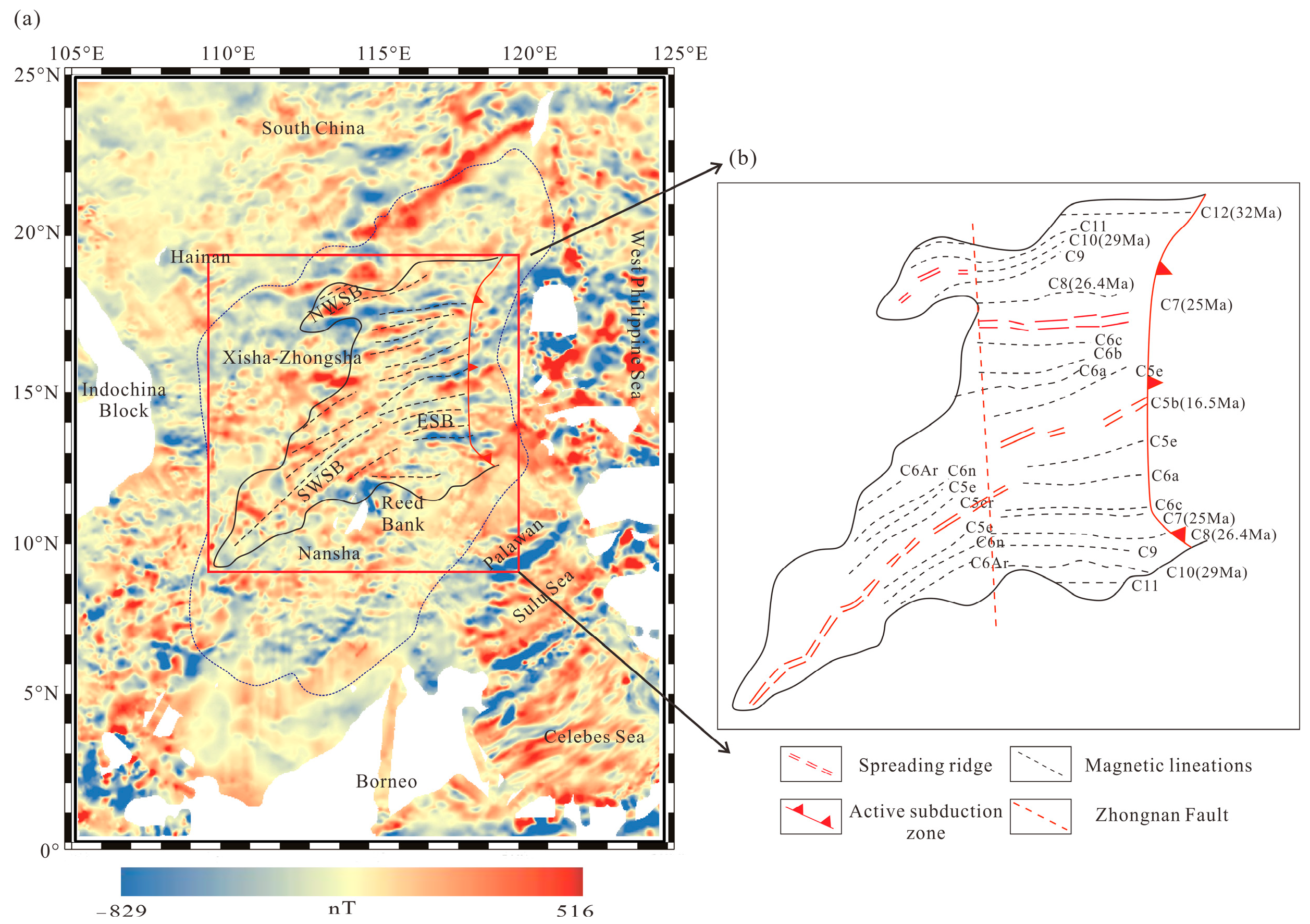
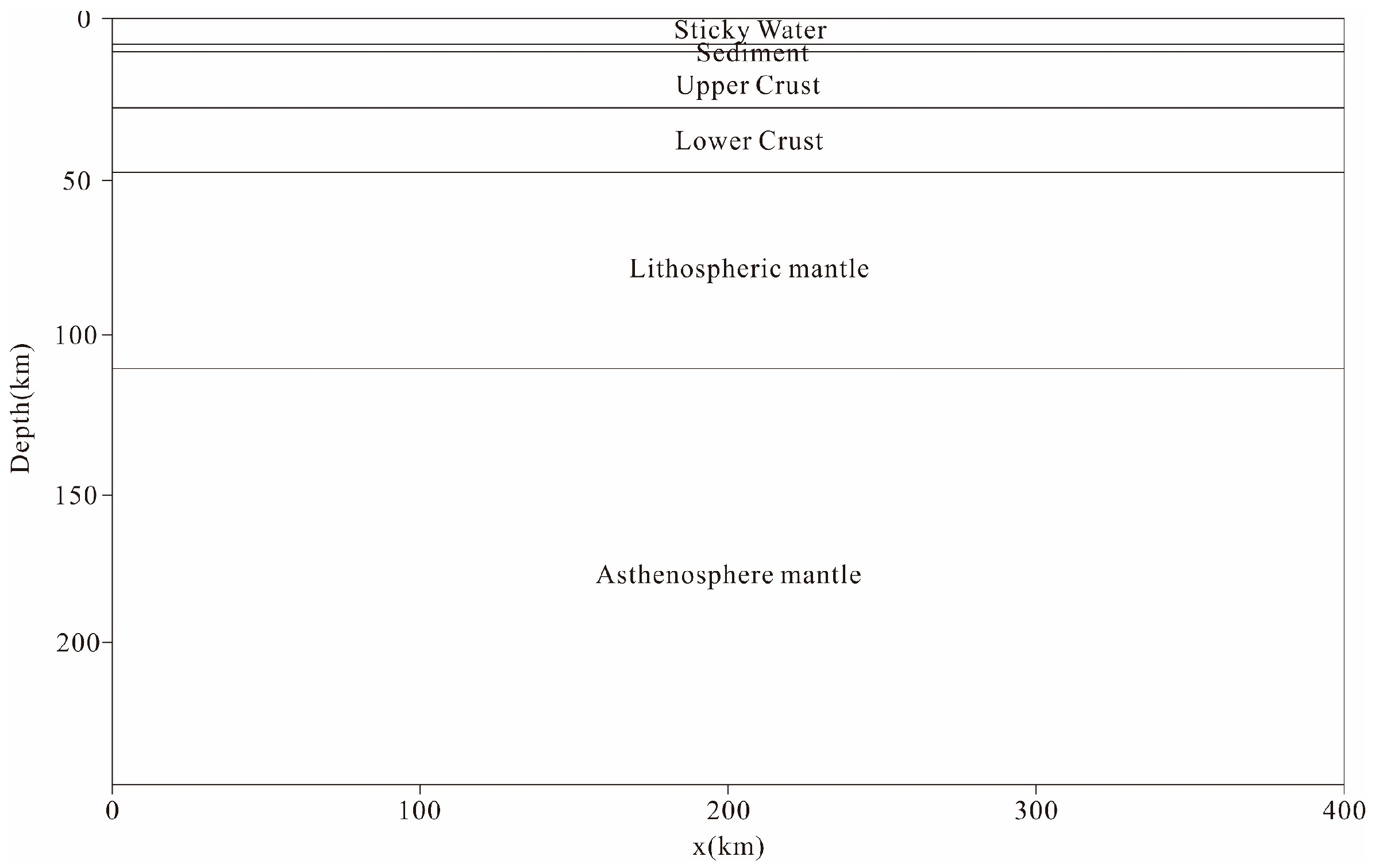
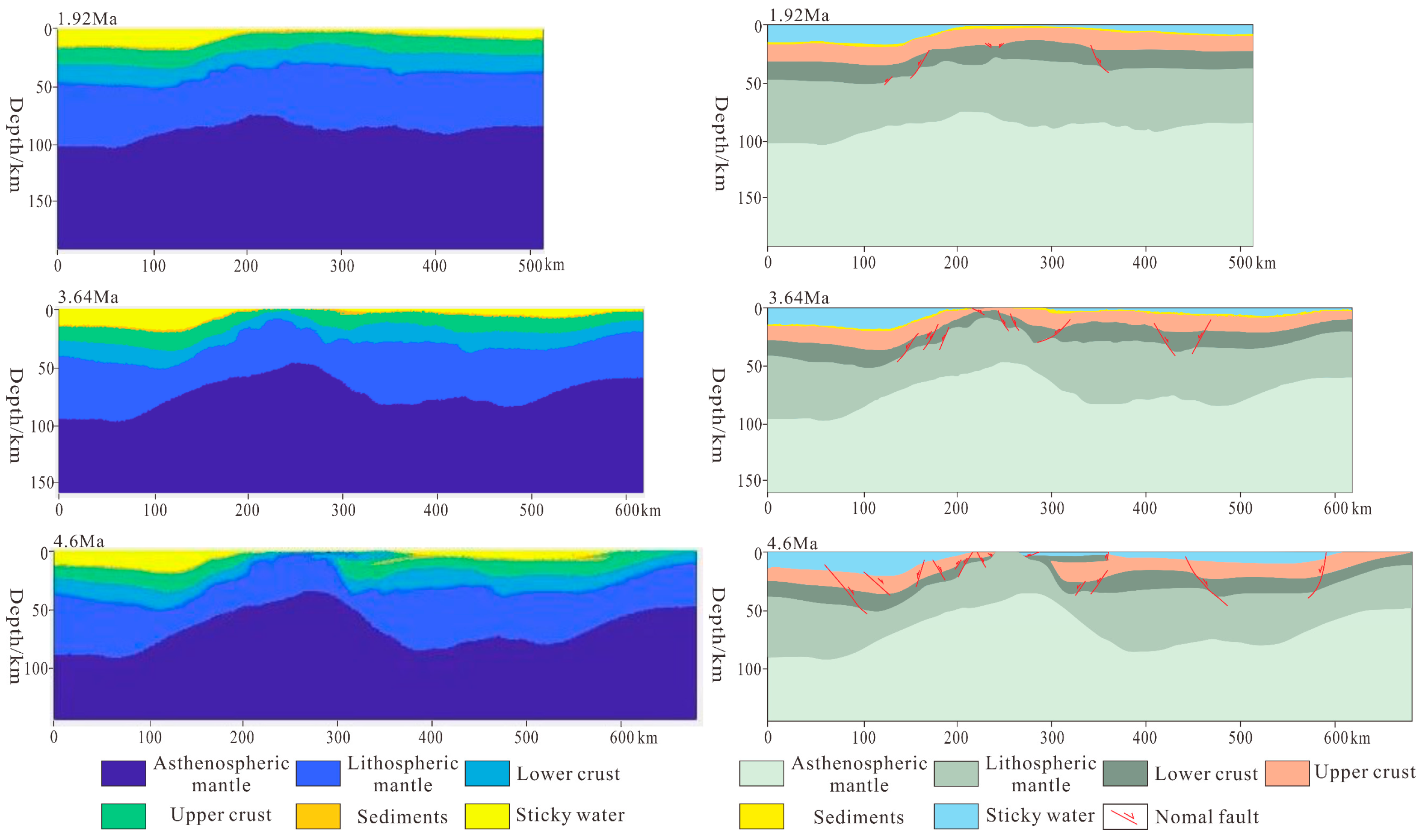

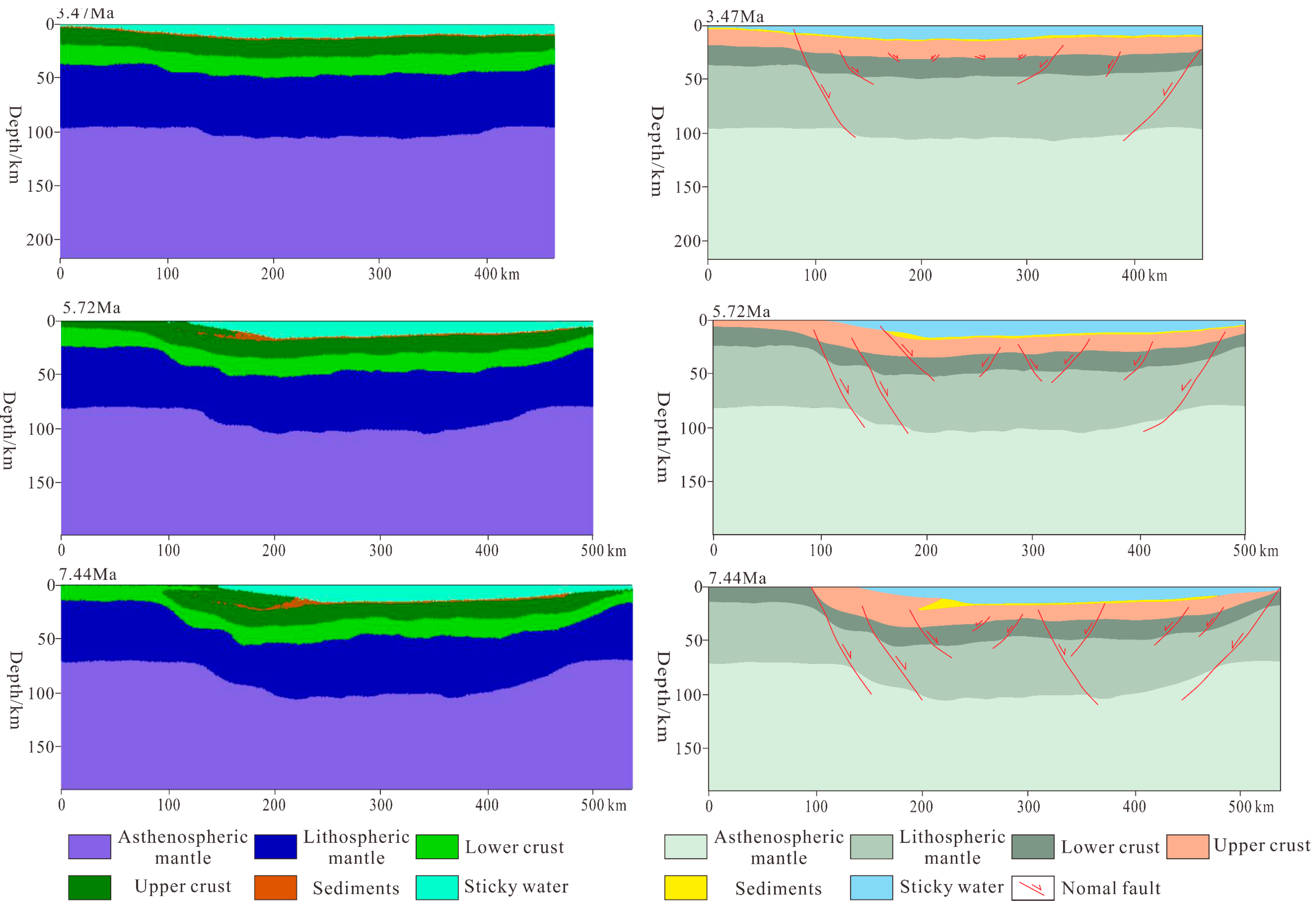
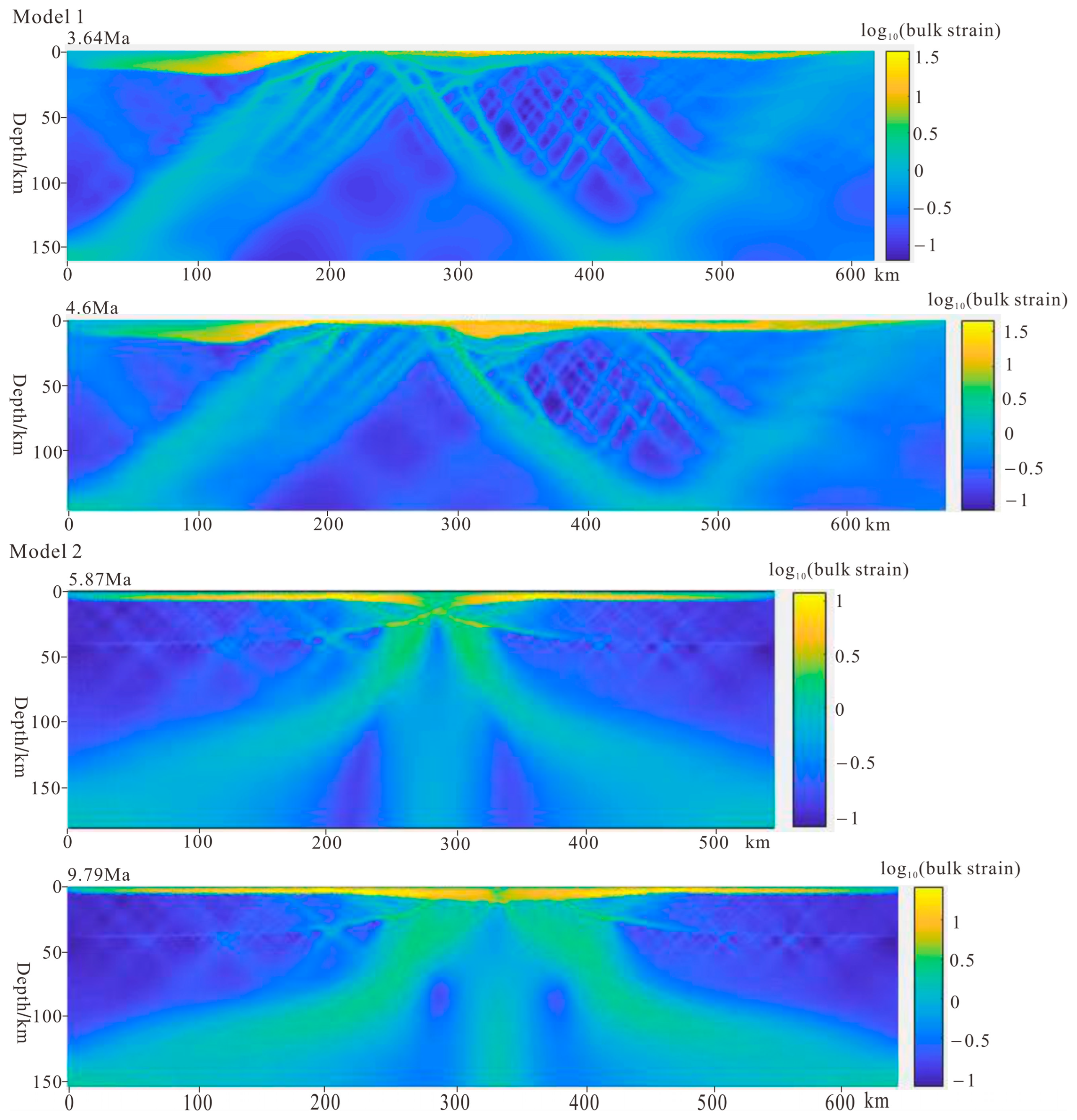
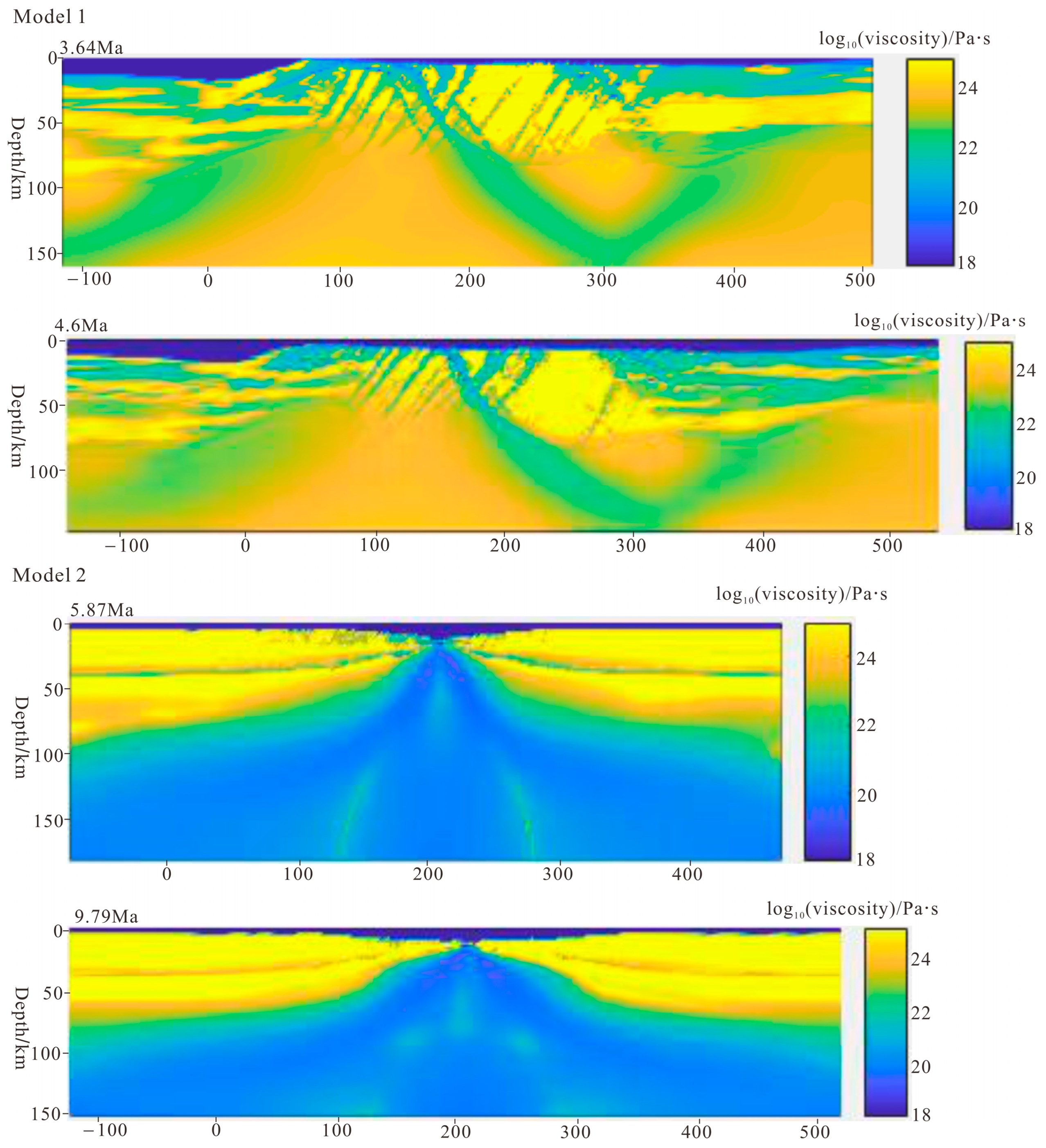
| Sticky Layer | Sediment | Upper Crust | Lower Crust | Lithospheric Mantle | Asthenosphere Mantle | |
|---|---|---|---|---|---|---|
| (kg/m3) | 1000 | 2650 | 2700 | 2800 | 3300 | 3300 |
| n | / | 2.3 | 4 | 3.2 | 3.5 | 3.5 |
| Ea (kJ/mol) | / | 154 | 223 | 238 | 532 | 532 |
| (1/K) | 2 × 10−5 | 2 × 10−5 | 2 × 10−5 | 2 × 10−5 | 2 × 10−5 | 2 × 10−5 |
| (1/Pa) | 1 × 10−11 | 1 × 10−11 | 1 × 10−11 | 1 × 10−11 | 1 × 10−11 | 1 × 10−11 |
| AD (1/s/MPan) | / | 3.2 × 10−4 | 1.1 × 10−15 | 5.6 × 10−17 | 2.4 × 10−8 | 1.9 × 10−9 |
| k0 (W/m/K) | 300 | 0.64 | 0.64 | 1.18 | 0.73 | 0.73 |
| a (W/m) | 0 | 807 | 807 | 474 | 1293 | 1293 |
| Cp (J/kg/K) | 3000 | 1000 | 1000 | 1000 | 1000 | 1000 |
| Hr (W/m3) | 0 | 2 × 10−6 | 1 × 10−6 | 5 × 10−7 | 2.2 × 10−8 | 2.2 × 10−8 |
| Va (cm3) | / | 0 | 0 | 0 | 10 | 10 |
| C0 | 0 | 1 × 107 | 1 × 106 | 1 × 106 | 1 × 107 | 1 × 107 |
| C1 | 0 | 1 × 107 | 1 × 106 | 1 × 106 | 1 × 107 | 1 × 107 |
Disclaimer/Publisher’s Note: The statements, opinions and data contained in all publications are solely those of the individual author(s) and contributor(s) and not of MDPI and/or the editor(s). MDPI and/or the editor(s) disclaim responsibility for any injury to people or property resulting from any ideas, methods, instructions or products referred to in the content. |
© 2024 by the authors. Licensee MDPI, Basel, Switzerland. This article is an open access article distributed under the terms and conditions of the Creative Commons Attribution (CC BY) license (https://creativecommons.org/licenses/by/4.0/).
Share and Cite
Liu, C.; Li, J. Geodynamic Mechanism of the Evolution of the South China Sea Basin: Simulation Based on the Finite Difference Method. Appl. Sci. 2024, 14, 1301. https://doi.org/10.3390/app14031301
Liu C, Li J. Geodynamic Mechanism of the Evolution of the South China Sea Basin: Simulation Based on the Finite Difference Method. Applied Sciences. 2024; 14(3):1301. https://doi.org/10.3390/app14031301
Chicago/Turabian StyleLiu, Chen, and Jianghai Li. 2024. "Geodynamic Mechanism of the Evolution of the South China Sea Basin: Simulation Based on the Finite Difference Method" Applied Sciences 14, no. 3: 1301. https://doi.org/10.3390/app14031301
APA StyleLiu, C., & Li, J. (2024). Geodynamic Mechanism of the Evolution of the South China Sea Basin: Simulation Based on the Finite Difference Method. Applied Sciences, 14(3), 1301. https://doi.org/10.3390/app14031301





